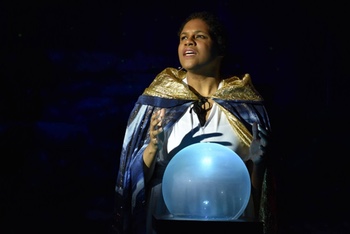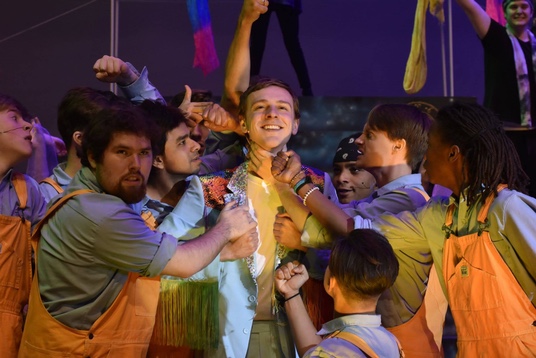Through Sun 12/11
Joseph and The Amazing Technicolor Dreamcoat, the Andrew Lloyd Webber and Tim Rice musical, had an unusual path to being one of the oft-produced musicals of all time. It has been estimated that world-wide, over 20,000 school, community and professional theaters have produced the work.
As the creation story goes, in 1967, when Webber was 19 years old, he was asked to write a pop cantata for a school choir to sing at their Easter end-of-term concert. He asked his friend Tim Rice to write lyrics for the project. They decided to base the work on the story of Joseph from the Biblical book of Genesis.
Joseph started as a 20-minute choral piece. The show gradually developed into what is now a full script. It is, however, a different type of script than most musicals. In fact, it is not a script at all, just a collection of 20 songs arranged in chronological order, with no narrative and no stage directions. This is why each production of the show takes on a different approach.
Sometimes the presentation is done in two acts, sometimes in one. It has been staged as a bedtime story in pajamas, a Biblical epic complete with clothing of the time of Jacob, a fantasy costumed in out-of-this world clothing, and with and without a chorus. The Near West Show theme centers on Joseph and His Son’s Construction Company. It’s been done by a cast of 20 or, as is true of the Near West Theatre’s production, 52 performers appear.
The Narrator explains, in the “Prologue,” the background to the story”: this is a tale of Joseph, whose clairvoyant powers, intelligence and charm lead to both his being his father’s favorite and the wrath of his 11 brothers (“Jacob and Sons”). The envy increases when Jacob gives Joseph, a symbol of respect (“Joseph’s Coat”). His “bros” get rid of him by attempting fratricide, but change their minds sell him to some passing Ishmaelites (“Poor, Poor Joseph”), who take him to Egypt. They explain his “death” to their father in “One More Angel in Heaven.”
Joseph eventually becomes the Pharaoh’s favorite when he successfully enciphers the leader’s nightmares (“Pharaoh’s Dreams Explained”) and saves Egypt from famine. He becomes the second in command, eventually forgives his brothers when they come to beg for food (“Grovel/Grovel”) and, in an emotional climax, reunites with his father (“Jacob in Egypt”).
The play concludes with the audience on its feet clapping as the cast sings ‘Any Dream Will Do” and “Give Me My Colored Coat”.
Like many of Andrew Lloyd Webber’s conceptions, which include Cats, The Phantom of the Opera, Jesus Christ Superstar, Evita, Aspects of Love, and Sunset Boulevard, much of the music is infectious. There are parodies of French ballads (“Those Canaan Days”), rock and roll (“Song of the King”), western (“One More Angel In Heaven”), 1920s Charleston (“Potiphar”), Calypso (“Benjamin Calypso”), and go-go music (“Go, Go, Go Joseph”). Tim Rice, the lyricist and Webber’s longtime collaborator, not only has written for Broadway, but for such Disney shows as Aladdin, Beauty And The Beast and The Lion King.
Joseph and The Technicolor Dreamcoat is an ideal show for Near West Theatre, which serves as both a production house and a safe place for youngsters, tweens, teens and adults. Its audience is as diverse as its performers and technicians. Few theaters have the massive stage to allow for the huge cast, and gimmicks such as a real golf cart to be incorporated into the show.
Kelcie Nicole Duggar, the Narrator, has a fine voice and the ability to sing meanings, not just words. Her “Prologue” set a perfect tone to start the show. Robert Kowalewski is not the studly leading man image, but has a sweet quality that made Joseph into a charmer. His “Close Every Door” was well interpreted and sung.
At times, due to the mass of bodies on stage, Joshua Landis’ choreography looked like mass chaos rather than coordinated movements. The same could be said for much of Bob Navis Jr’s staging. Maybe, in the future, consideration should be given to double-casting roles, with performers on alternate nights, or only having part of the cast appear in some numbers.
Navis has incorporated many shticks and gimmicks into the show, adding a joyousness to some scenes, eliminating some of the cleverness in others. Someone sitting behind me commented in disappointment that the “Elvis Song,” (“Song of the King”) didn’t have the traditional white-suited, hip swiveling rock-a-billy sound and visual imagery. (Cory Markowitz, the Pharaoh, did a nice job with the “new” arrangement of the song.)
Navis kept the show moving right along, though some of the set changes seemed overly long. Ben Malkevitch’s musicians did a nice job of supporting, rather than drowning out the performers, especially in the solos.
It must be a major challenge to costume such a giant cast. In general, April Rock’s costumes worked, but Joseph’s coat of many colors was underwhelming. The words to the song list the many colors of his coat. A short jacket with fringe, with a couple of color patches, does not “a coat of many colors” make!
CAPSULE JUDGMENT: Joseph and The Amazing Technicolor Dreamcoat is a fun show for audience of all ages. As evidenced by the extended applause at the end of the show and the many instances of audience delight displayed during the production, the cast’s and crew’s efforts were appreciated. Near West Theatre should be praised for carrying out its mission of empowering children, teens and adults through transformational arts.
Joseph and the Technicolor Dreamcoat runs At New West Theatre through Sun 12/11. Call 216-961-6391 or go to http://www.nearwesttheatre.org for tickets and information.
[Written by Roy Berko, member, American Theatre Critics Association, Cleveland Critics Circle]

